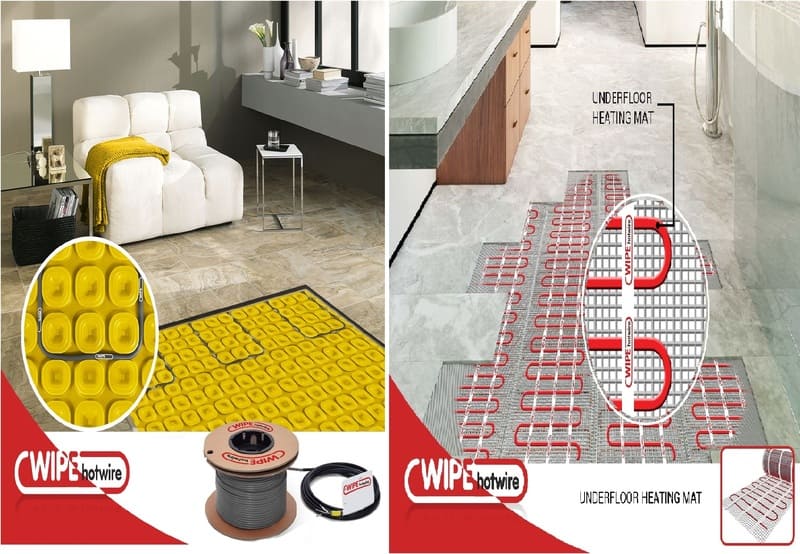Radiant Heat Floor Warming
The radiant heating system helps heat spread evenly from the ground, get absorbed by the objects and then spread evenly throughout the room, creating a sense of comfort. This is unlike the traditional heating systems (Radiators, Forced Air heat) where warm air gathers at the ceiling, leaving cold feet and cold pockets all around.
Think of RFH like heat from the sun. On a sunny day, if you step from the shade into the sun, you'll feel warmer even though the air temperature is basically the same. This is how radiant floor heating works. Temperature throughout the room is more constant than with your standard forced-air system, where the air rises, cools and then falls to the floor.
Factors to consider when choosing electric Radiant Heating System for Homes/Offices
Will the system be used as a main or supporting source of Heating?
It will depend on many factors such as new or renovation job (radiant heating systems suit both), severity of weather conditions, building insulation, number of doors & windows, height of the ceiling, location ( like bedroom, living room, kitchen, bathroom, office, passages, etc.), already installed heating equipment (like Radiators, Hydronic) and type of installation surface. A main system will require close cable spacing and heat density of about 150W/sq.m. Heating system cables are available in coil form which allows them to be placed with different spacing to give different heat output as per location or heating mats affixed with preformed cables are available with set output of 100W/sq.m. or 150W/sq.m. These are easy to roll out and get installed (even as DIY).
In case if old buildings with high ceilings or large rooms, supplementary wall mounted space heaters can be installed for use in extreme winters or quickly heating the room.
What is the area of the room to be covered?
The surface that the heating cable/mat will cover must always be about 10% less than the total surface area that needs to be heated (exclude very low furniture, bathtubs, modular furniture, wardrobes, etc.). The heating cable must never be cut, so normally power/length calculation guide is generally available at the time of ordering. A place must be decided for installing a wall thermostat.
What is the installation surface?
Electric radiant heating system is compatible with most installation surfaces like mortar bed, cement board, smooth concrete, plywood, ceramic tiles, and stone. The installation method will change depending on the floor available. Normally, installation manuals are provided with the cable/mat.
What type of floor covering will be installed?
A wide variety of floor coverings are available for installation. These include ceramic tiles, natural stone, marble, engineered wood, vinyl, floating floor, carpet, etc.
The type of covering will have an impact on the suggested cable spacing and heat distribution.
Electric RHF works best with floors made of ceramic tile, but it can be used with most types of flooring, including hardwood floors. Carpet is thicker and doesn't conduct heat as well as tile or hardwood flooring, but selecting the correct padding can greatly increase the amount of heat you'll get.
Which voltage is available in the room?
Choosing 120V or 230/240V has no impact on energy consumption (you must select this while ordering). If you already have or going to have one of these voltages available in the room, a system can be ordered accordingly by specifying the power and length requirements. The system also requires a compatible, manual or programmable thermostat, which should be ordered as a part of the system.
Energy efficiency
Electric radiant heating systems offer substantial energy savings. They remain ‘on’ until a uniform and comfortable temperature is achieved throughout the room, then they are automatically cut off and switched on again to maintain the set temperature. This results in energy saving of up to 28 % compared to conventional heating systems. The benefit increase with the size of the area to heat.
Safety
Most electric radiant heat systems carry the relevant safety certifications and have no shock hazards. The heating wires are normally double insulation Class II and the cables installed below the floor embedded in mortar/concrete are perfectly safe.
Warranty
All well-known brands come with a minimum 10 year performance warranty. The system requires no maintenance post installation and there are no moving parts to wear our or materials to rust or deteriorate. The system has almost an indefinite life.
No noise
Radiant floor heating systems are known for being quiet. Unlike forced-air systems, there isn’t a loud furnace that kicks on. Therefore, you won’t hear anything while they’re on.
Non-allergenic
Because floor-heating systems directly warm the people and objects in a room via radiant heat, they do not disturb any existing dust and allergens. This is a major downfall for forced-air systems, which blow around dust and other particles while they distribute heat.


Leave a reply